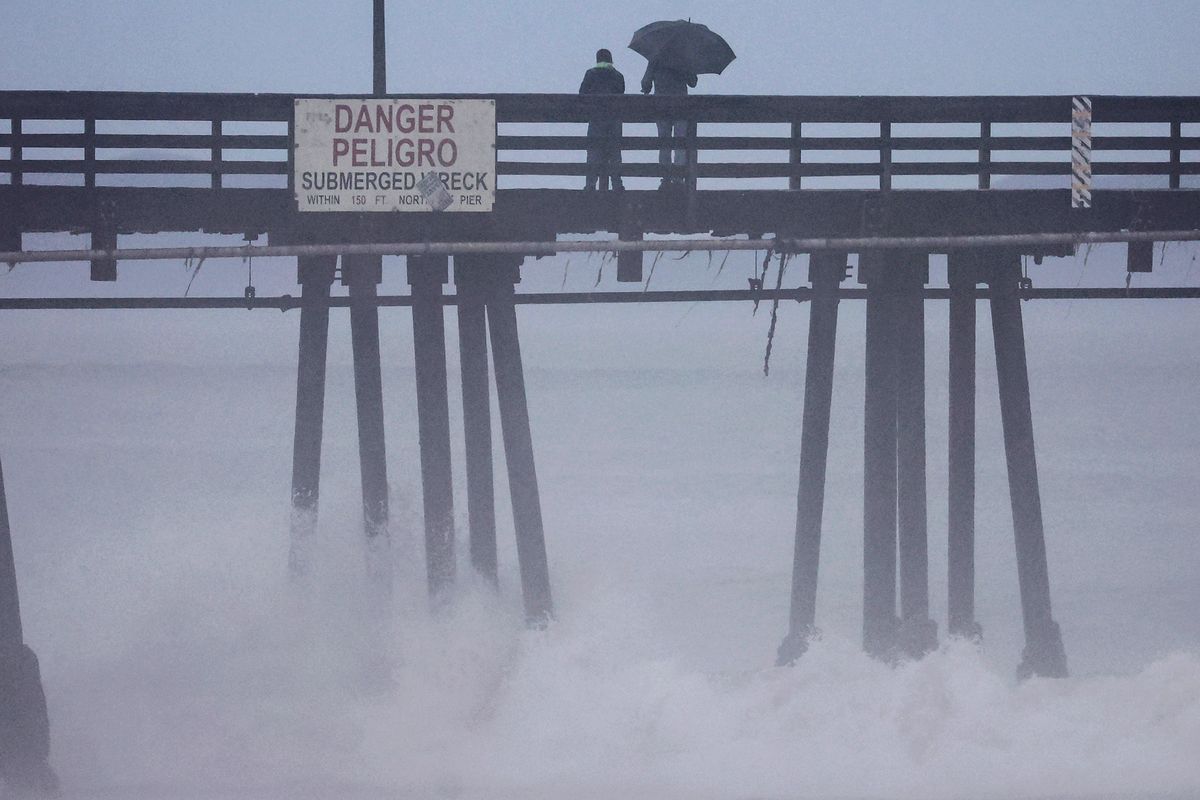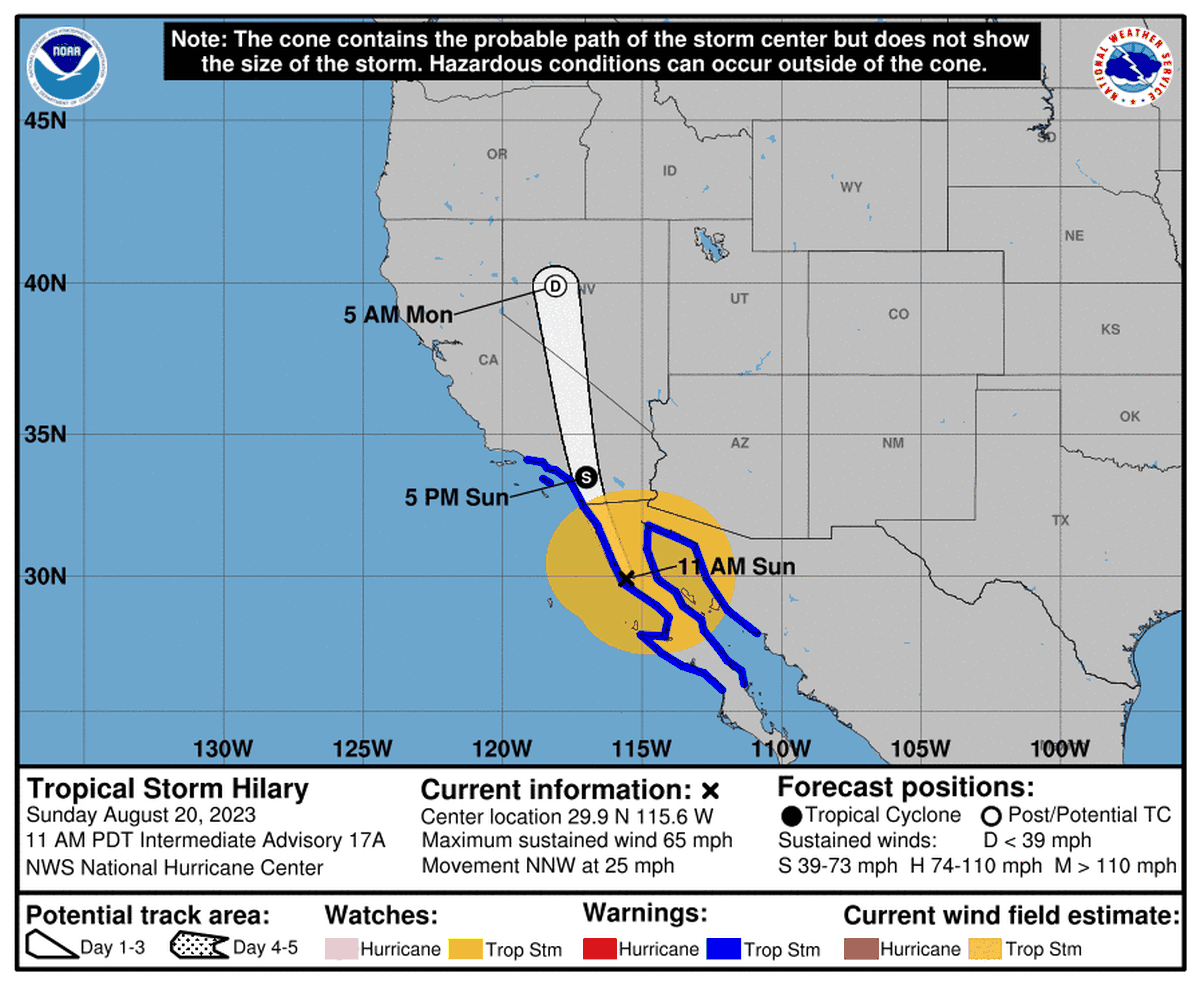‘Widespread flooding’ expected across Southern California as Hilary moves in
People stand on a pier over the Pacific Ocean with Tropical Storm Hilary approaching in San Diego County on Sunday in Imperial Beach, Calif. Southern California is under its first tropical storm warning as Tropical Storm Hilary approaches with parts of California, Arizona, and Nevada preparing for flooding and heavy rains. All California state beaches have been closed in San Diego and Orange counties in preparation for the impacts from the tropical storm. (Mario Tama)
Los Angeles Times
LOS ANGELES – After days of urgent warnings, Tropical Storm Hilary made landfall in Baja California on Sunday, turning roads into rivers and imperiling homes before barreling north toward Southern California.
By 6 p.m. in the Southland, flooding, downed trees, road closures and high winds had hit the region with force. And school closures were announced for Monday in districts including Los Angeles and Palm Springs.
The National Weather Service, in a 6:45 p.m. announcement, warned of life-threatening flooding amid heavy rain in western L.A. County and eastern Ventura County, generally west of Point Dume in Malibu and east of Point Mugu. Areas affected included Camarillo and Newbury Park.
Forecasters with the National Weather Service in Las Vegas said conditions were continuing to deteriorate across parts of Southern California and western Nevada, especially in the mountains and deserts. They said there continued to be the possibility of some life-threatening, catastrophic flooding.
Earlier in the afternoon, with Southern California focused on storm preparations, a magnitude 5.1 earthquake rattled Ojai. It was another reminder of Mother Nature’s unpredictable temperament for a region already on edge.
As the remnants of Hilary moved north into California on Sunday afternoon, Los Angeles Mayor Karen Bass warned during a news conference that “the worst of the rains is potentially left to come.”
Flanked by Gov. Gavin Newsom, city officials and emergency responders, she noted the winds were also likely to pick up during the evening and night.
“Fortunately, we have had no reports of any injuries or significant damage at this time,” Kristin Crowley, L.A. fire chief, said at the news conference, but there were a few minor incidents: One person had been rescued from a flooded car, wires were down throughout the city, two debris flow incidents had occurred in the Sherman Oaks area, and a large tree had toppled over in Westwood.
She also noted that about 5,000 people were without power in the city, mostly in the Boyle Heights and Hollywood areas.
At 5:30 p.m., the National Weather Services reported rainfall totals of 4.32 inches in Palmdale, 4.28 inches in Saugus and 4.21 in Valyermo. Along the coast and in the San Fernando and San Gabriel valleys, totals were significant but smaller: 1.89 inches in Beverly Hills, 2.02 inches in Northridge and 1.81 at Eagle Rock Reservoir.
Along the Baja California peninsula, where Hilary plowed through earlier in the day, at least one person was reported drowned in the Mexican town of Santa Rosalia when a vehicle was swept away in an overflowing stream. Rescue workers saved four other people, said Edith Aguilar Villavicencio, the mayor of Mulege township.
On Sunday afternoon, the Los Angeles Unified School District announced that schools would be closed Monday to ensure that campuses could be inspected after Hilary passed through and to avoid potential morning commute hazards. The uncertainty brought by the storm led to wide-ranging – but not universal – public school closures for Monday across much of the Southern California region, including in Pasadena, Palm Springs and San Diego.
President Biden weighed in Sunday evening, noting that he had deployed the Federal Emergency Management Agency and the U.S. Coast Guard so that “federal personnel and supplies that can be surged to impacted communities” and in place should there be a need “for rapid response and search-and-rescue efforts.”
“My Administration stands ready to provide additional assistance as requested. I urge people to take this storm seriously, and listen to state and local officials,” he said in a statement.
Across Southern California, residents in flood-prone areas gathered to fill sandbags as shoppers emptied shelves of batteries, water and other goods. Beaches in San Diego, Orange and Los Angeles counties were ordered closed.
The National Weather Service issued flash flood warnings for Los Angeles County through 7:45 p.m. The heaviest rains in Southern California were expected to fall in the mountains and deserts. Riverside and San Bernardino counties, where the worst of the storm was expected to hit, were anticipating 5 to 10 inches of rain for their mountains and desert areas.
“That’s the area of the most concern and of the greatest risk of significant flooding,” said Ryan Kittell, a National Weather Service meteorologist in Oxnard. Places such as Lancaster – which averages 7 inches of rain a year – were expected to nearly hit that total in one day.
By noon, there were some road closures in Southern California, including a section of Pacific Coast Highway in Huntington Beach and truck lane connectors from the 5 Freeway to Highway 14. Major theme parks also closed. Knott’s Berry Farm and Six Flags Magic Mountain closed, and Disneyland announced it would shut its doors early.
The center of the storm had been forecast to hit San Diego on Sunday afternoon and move northeast, reaching the borders of Los Angeles and San Bernardino counties by evening, said Joe Sirard, meteorologist at the National Weather Service in Oxnard.
A boulder fell along state route Highway 98 near Calexico as the storm pressed down in the region. But early Sunday evening, parts of San Diego County, including the city itself, were experiencing relatively calm weather.
That was largely because of the storm’s positioning and the way the mountains were blocking some of the wind and rain coming from the east, said Daniel Swain, a UCLA climate scientist.
“There have been some wind gusts up above 80 mph so far in the San Diego County mountains, but there hasn’t been very much wind down at ocean level in San Diego County. That’s because the mountains are both blocking the wind and intercepting a lot of the precipitation,” Swain said. “So San Diego is ironically in the rain shadow.”
“Despite being closer to the center of the storm than anywhere else in California, [San Diego County] has yet to receive any really alarming conditions,” Swain said. “It’s breezy and kind of drizzly and very humid and muggy and kind of weird, tropical atmosphere, but nothing destructive yet, in the western part anyway.”
Elsewhere, farther east, reports of flooding poured in, including inside the Eisenhower Medical Center Hospital in Rancho Mirage. In the town of Thermal, power went out as heavy rain fell. Winds were buffeting trees in Coachella on Sunday evening, and some roads had flooded.
Earlier Sunday, as evacuation warnings remained in places such as Santa Catalina Island and some communities in San Bernardino and Riverside counties, and reports of flood and wind damage piled in, some residents from Southern California to Tijuana – many of whom had never experienced a tropical storm – shrugged off the dangers of the storm.
“My plan is, I’m just gonna stay right here and I’m just gonna work,” said Johnathan Muñoz, a candy seller in the Tijuana neighborhood of Aviacion.
In advance of the storm, the Mexican government put 18,000 soldiers on alert. Officials in the flood-prone Tijuana area opened five temporary shelters and reported that families had already begun arriving late Saturday night. Beaches were also closed.
“I’m just praying that nobody gets hurt,” Muñoz said.
But several said they hadn’t taken precautions even as they knew that the poor infrastructure was unlikely to prevent flooding.
“‘I’m going to be here,” said Julian Castillo, whose family has lived in Tijuana’s middle-class Colonia Castillo neighborhood since the 1990s. Just a block away, deep murky water pooled at the bottom of a hill.
“It always gets flooded. When it rains down there it clogs very easily,” Castillo said. “People here don’t clean up the storm drains before the rain. They do it after something happens.”
Over the border in California, San Bernardino County Fire Battalion Chief Mike McClintock said more than 100,000 sandbags had been distributed to residents at fire stations over the last couple of days.
Other county departments are busy clearing out floodways and evacuating homeless people along drainage areas in the region. The county has added more than 50 people to swift water evacuation and strike teams so they can more quickly respond to emergencies, McClintock said.
“We have an all-hands-on-deck approach to getting things going,” he said. “This tropical storm making landfall is kind of historic in our generation. … We are not taking that lightly.”
The county has ordered evacuations in mountain areas with serious burn scars from the El Dorado and Apple fires in recent years.
“We’ve seen over this last rainy system immense amount of mudflow and debris flow going downhill in those areas,” McClintock said. “We have been preparing, but better safe than sorry, and we’re asking residents in those areas to heed those warnings.”
Officials urged residents to take the storm seriously and monitor forecast updates and ensure they have multiple methods of receiving warnings, including wireless emergency alerts, weather apps and local TV, radio and news stations. Los Angeles officials said they were ready to evacuate people if need be.
At the Fuente de Agua Viva, a church in Mecca, 50 people gathered for the Sunday 11 a.m. service. The storm had not yet reached the Riverside town, although a light rain fell.
“How many are scared because of the hurricane,” Pedro Miranda, the minister asked, as he held up his arm for a show of hands. Nobody raised theirs.
Miranda had initially planned to hold the service outside, “but the Lord’s plan was for us to be here,” he said, before leading worshipers in a prayer for those in affected areas.
“We’re going to thank God because he is good,” Miranda said. “Our desert needs water.”
Among those attending the service was Olga Granados, who wore a black head covering with green trim. She said she hadn’t seen anything weather-wise to make her worry, just occasional rain.
“We’re calm here,” she said with a smile.
“We got 30 bags and no rain,” a young man complained outside the church, as he recounted to a friend that he’d stocked up on sandbags.
Fears of flooding, landslides and dangerous coastal rip currents prompted Newsom to declare a state of emergency Saturday evening, and Bass signed a local emergency declaration.
He toured the San Bernardino County Emergency Operations Center on Sunday.
There seemed to be little worry about the impending storm among some truckers in the Whitewater rest area, off the 10 Freeway in Riverside County.
Jeff Moore and his wife, Laura, were killing time before they had to pick up a load of Nestle water in Cabazon. From there, they planned to head to Casa Grande, Ariz.
The 52-year-old couple, who were driving from Las Vegas, said they hadn’t heard about the hurricane.
The pair had driven in worse weather, Laura chimed in, and at times when you couldn’t make out the lines on the road. Laura recalled a tornado that hit while they passed through New Mexico.
What did she do then?
“I just drove,” she said. She wasn’t worried about the storm.

